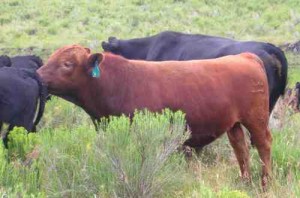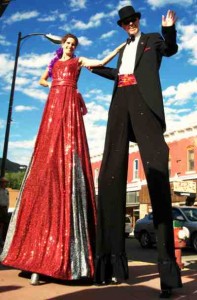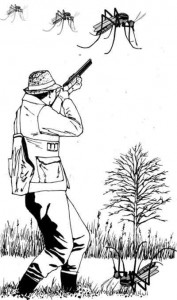Review by Ed Quillen
Guidebook – August 2007 – Colorado Central Magazine
Colorado Trails – South-Central Region
by Peter Massey and Jeanne Wilson
Published in 2006 by Adler Publishing
ISBN: 1930193297
Colorado Trails – Southwest Region
by Peter Massey, Jeanne Wilson,and Angela Titus
Published in 2007 by Adler Publishing
ISBN: 978-1-930193-07-9
MY PROBLEM with guidebooks is twofold. One is that they take away some of “the thrill of discovery,” and the other is that they encourage more people to be out in our back country, which is where we go to get away from people.
That said, both of these are informative and well-organized, providing guidance not only for specific routes, but for back-road four-wheeling in general: the vehicle and its configuration, useful tools including GPS, not cutting new roads, etiquette, etc.
There was little to quarrel with here, although of course I found something. In their discussion of the heavy-duty jack (sold under trade names like “Hi-Lift” and “Handyman”), they did not caution that you should hold the handle quite firmly when letting something down, unless you like the taste of your own teeth or are prepared to lose other body parts. There’s a reason these are often called “widowmaker jacks.”
Also, in their discussion of other “vehicle recovery methods,” they left out the familiar “come-along” or “hand-puller.” Mine has pulled me out of a few jams. I was nervous the whole time I had the come-along and connective chains rigged, so perhaps there are good reasons not to recommend these “poor man’s winches.” But if so, they should have presented these reasons.
Most of their general four-wheeling advice can be summed up as “take it easy” and “when in doubt, get out and walk ahead before proceeding.” Over the years, I could have saved myself considerable time and money by following these precepts.
The South-Central guidebook covers 30 routes. They rate routes from 1 to 10 in difficulty, with 1 the easiest and something most passenger cars can handle in good weather, like Marshall and Black Sage passes. These are called “roads” here; everything from 2 on up is a “trail.” That jarred me at first, since I figure if you can drive it, it’s a “road,” and if it’s for hiking, it’s a “trail.”
The most difficult trails listed here, like Schofield Pass between Crested Butte and Aspen, are rated 6: “Experienced four-wheel drivers only. Potentially dangerous large rocks, ruts, or terraces may need to be negotiated; steep slopes, loose surface, and/or very narrow vehicle clearance; stream crossings at least 24 inches deep, and/or unstable stream bottoms, or difficult access; very narrow shelf road with steep drop-offs and challenging road surfaces to be expected.”
Many hard-core back-roaders consider the Como Lake Trail at Mt. Blanca to be the hardest route in the state, a definite 10, and it’s not listed here, presumably on grounds of good sense. Nor are Mosquito and Hagerman passes, because the Leadville area is “North-Central” in this series. They also left out the North Fork and Middle Fork roads west of Salida, but they did include some local challenges like Mt. Antero.
Each of the 30 South-Central trails gets a list of particulars, such as mileage and start and end points, a description, and a brief history, for which the writers should be commended, because guidebooks too often neglect our rich past. There’s a number to call for current road conditions, as well as a map and a list of relevant maps with more detail. Then come the specific directions, given by mileage in both directions, telling you where to turn and where not to — some very useful information on certain roads.
So, how good are the directions? The best way to find out is to try them. For years I’ve thought about crossing Hayden Pass, but never got around to it. With the book and our 1990 Blazer with cracked windshield, Martha and I set out on the last day of June to tackle it, per the guidebook.
Hayden crosses the Sangre de Cristo Range between Villa Grove and Coaldale. It’s been in use since the 1870s, and was once considered as a route for U.S. 50. It is rated a 7 for scenery, and it did offer some grand views on both sides. It is rated a 3 for difficulty, just like Tincup Pass, which I once crossed in a Volkswagen Superbeetle.
So I didn’t expect Hayden to be as steep and rocky as it turned out to be, even though the book warned that some sections are “steep and quite rough and require high clearance.”
Thus the description was accurate, as was the guidance, and we got over Hayden just fine. We didn’t see another vehicle, not even an ATV or motorcycle, on the entire 4WD portion of the route, which is flanked on both sides by official Wilderness. Although the Blazer ran pretty hot going up and scraped bottom and sides a few times, it didn’t make many strange noises after we got home.
The Hayden history here notes that it was not named for the famous 19th-century surveyor and geologist Ferdinand Vandeveer Hayden, but for “an early settler of the Wet Mountain Valley, Lewis Hayden.” But Hayden Creek on the east side flows to Coaldale in the Pleasant Valley portion of the Arkansas Valley, not to the Wet Mountain Valley, so why would a Wet Mountain pioneer’s name be on it and the pass that ascends the creek?
A more likely namesake, according to Carol McNew’s area history Beyond the Gorge would be Lymon Hayden, an early rancher in Pleasant Valley.
Anyway, this guidebook does a fine job of telling you how to get from here to there and what you can expect along the way, along with some relevant lore.
The Southwest Region guidebook is quite similar to the South-Central, albeit with 48 routes instead of 30. It has many more pictures, as well as some pages of general history (like the Silver Crash of 1893) and explanation (various mining methods).
Decades have passed since I had the youthful courage to tackle back roads in the San Juans, but the book has the routes that I still have nightmares about, like Engineer and Ophir passes, as well as many others, all with photos and copious guidance.
So if you’re looking for some interesting back roads with a wide range of difficulty, ranging from passenger-car to over-size tires and a powerful winch, these books will show them to you, while giving you some driving advice and local lore. As guidebooks go, these are first-rate.



